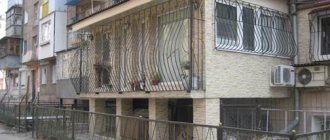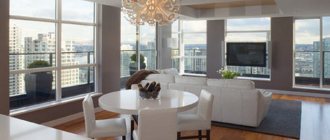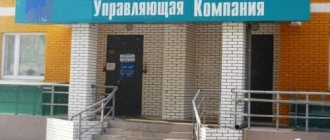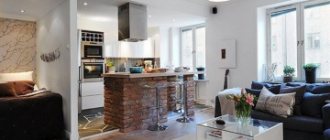Everyone who was faced with choosing an apartment noticed an interesting trend: an apartment on the first floor often costs 5-10% cheaper than on the other floors. According to statistics, such housing is less in demand and is slowly being sold out. Since the times of the Soviet Union, the idea that the first and last floors of a house are almost illiquid has been firmly rooted in people’s minds.
Of course, in this matter everything is not so simple and before making the final choice, you need to dig deeper. We will help you understand whether an apartment on the ground floor has disadvantages or whether this option is better than others. Go!
Main disadvantages
The very first and main problem is that everyone living in such a house does not like the fact that anyone can look into the windows. Of course, this can be solved with thick curtains and blinds, but in the daytime it will be disturbed not only by the looks of passers-by, but also by noise.
Noise insulation
Yes, you can perfectly hear everything that happens on the street, just like outside you can perfectly hear what is happening within 4 walls. An additional irritant is the sound of the constantly opening elevator and entrance door. So sound insulation is the weakest point of such an apartment.
External environment
Almost every house (especially Khrushchev-era buildings on the secondary real estate market) has trees growing, blocking the sunlight for residents of the lower floors. In special cases, even during the day you have to turn on the lights, and this is an extra waste of electricity.
If, in addition, the windows look at the road, then the “bonus” will be constant dust on the windowsill and not only, as well as exhaust fumes and car noise. This point needs to be thought through in advance, because the hum of cars and constant dust can drive all apartment owners crazy, regardless of the number of floors, if there is a busy highway nearby.
So when buying a home, it is important to clarify where exactly the windows face. Otherwise, the problem of exhaust emissions will concern not only the first floor.
Useful material : How to invest money in building an apartment?
Safety
Security is of great importance, so all residents strive to install bars on their windows. This is the only way to protect yourself from burglars, but in return you can get the constant feeling that you are looking at the world through bars.
Residents are outraged by the fact that they are close to the basement and sewer system. Hence the constant dampness on the walls, ceiling and even in the closets. Unpleasant odors may occasionally disturb you; the cold floor will need to be additionally insulated. It is also possible that various insects or, in particularly advanced cases, even rodents may appear.
View from the window
Fans of panoramic views will have a hard time; you won’t be able to see the sunset from the window, because the maximum available view is to the nearest yard. And only if there are no tall trees near the window. And a number of other important aspects:
- Floods. There are high chances that anyone can flood you, because the entire riser is above you. Even if there is a leak in an apartment on the 6th floor, there is a chance that it will all come down to you;
- Proximity to the basement. Everything is clear here, but in addition to dampness a constant unpleasant odor can be added. In such conditions, fungus can quickly spread in the bathroom, which is unacceptable for allergy sufferers;
- The presence of a garbage chute. This point applies only to old Khrushchev and Brezhnevka buildings, because in modern new buildings the garbage chute is rarely placed inside the entrance. In summer, such a neighborhood is fraught with an incredible stench; these are excellent conditions for mice and rats;
- Usually there are no balconies or loggias on the first floors. For some people this may be a big deal.
In fact, these are the main problems that you are likely to encounter. But everything is not so bad; housing on the ground floor also has advantages. This is especially true for young couples with a child, elderly people and disabled people. For them, this choice will definitely be optimal.
We recommend you the article : Buying an apartment in installments.
What to do if the developer changed the apartment during the construction stage?
Despite the strict rules of the law on shared-equity construction, developers present many shareholders with unpleasant surprises along with the treasured keys. The Internet is full of stories about how people get something completely different from what they wanted: developers change not only the area of the objects, but also the layout of the apartments, their location on the floors and finishing materials. LIVING figured out which changes are legal and which are not. And what to do if in reality the apartment turned out to be different from the one in the contract.
Where are the parameters of the apartment under construction indicated, and what documents should the shareholder use to compare what he bought with what was built?
Basic information about the housing under construction is contained in the project declaration and the share participation agreement (section “property characteristics”).
According to Federal Law-214, the project declaration must contain information about the developer and all contractors, about the insurance of the construction company, about the results of the state examination of the design documentation for the house, about the rights to the land plot under the object under construction and about the construction financing scheme. In addition, the document contains building permit data, indicates the number of apartments in the house and their technical characteristics, explains the functional purpose of the house premises, and the planned connection to utility networks. Finally, the project declaration indicates when the developer plans to complete construction and when the house will be put into operation.
The equity participation agreement (DPA) contains more detailed information about the apartment itself: its area and location on the floor. The DDU must contain an explanation - a plan of the apartment under construction with a transcript. This document also indicates the finishing characteristics. Article 4 of Federal Law-214 regulates that the DDU must contain information about the material of the walls and floors of the house, its energy efficiency and seismic resistance class, its purpose, number of floors and total area.
Does the developer have the right to deviate from these documents?
The developer can change the project declaration and notify shareholders about this (on the company’s official website). For example, the area of the residential complex or the accompanying infrastructure may change.
All changes to the DDU must certainly be agreed upon with the shareholder.
At the same time, all changes made should not degrade the quality of the object. This is stated in Article 7 of the Federal Law 2014 (“The developer is obliged to transfer to the participant in shared construction a shared construction project, the quality of which complies with the terms of the contract, the requirements of technical regulations, design documentation and urban planning regulations, as well as other mandatory requirements”).
What to do if the changes are significant and the shareholder doesn’t like them?
If the changes that the developer makes to the project declaration infringe on the interests of the shareholder (for example, the developer builds a panel house instead of a brick one, refuses to build infrastructure facilities or changes the location of apartments on the floor), then the buyer has the right to make claims to the company.
Moreover, the developer is obliged to prove that the changes do not affect safety and do not violate the rights of shareholders. This was the decision made by the Supreme Court in a recent dispute.
If the developer changed the project at his own discretion and did not notify the shareholder about it (or the shareholder does not agree with this), then the buyer has several options. The first thing you can do is calculate the costs of eliminating the construction company’s mistakes, demand that they pay for them or redo the work.
If the shareholder is no longer satisfied with the apartment as constructed, he may demand termination of the DDU (in accordance with subparagraph 2 of paragraph 1.1 of Article 9 of the Federal Law No. 214). There are no uniform norms under which termination of a child-care facility is appropriate - a judge will decide on each specific case (termination of a child-care facility can only be done by a court decision). Most likely, in case of minor deviations from the contract (for example, if the apartment lacks an interior partition), the shareholder can count on a pre-trial settlement of the dispute (monetary compensation or the provision of a similar apartment without violations).
Finally, the shareholder can count on a change in the contract price (in accordance with paragraph 1 of Article 29 of the Law on the Protection of Consumer Rights). But first you will have to prove that changes in the project led to a decrease in the cost of the apartment.
I want the developer to redo everything at his own expense. How should I proceed?
If you want the developer to change the layout of the apartment at his own expense (for example, build a missing partition, if it is indicated in the DDU, or demolish the installed one), then you will have to:
1. Draw up and sign the defective act and the acceptance certificate.
2. Establish the amount of expenses for eliminating the developer’s mistakes (for example, for the construction of a new partition).
3. Send the claim to the developer (in two copies and with a receipt stamp). The deadline for responding to a claim is 10 days.
4. File a lawsuit (if the company refuses to satisfy the claim pre-trial).
The quality of the residential complex has not suffered much, but if I had known that the project would change, I would not have bought the apartment. What to do?
The Federal Antimonopoly Service (FAS) will help you understand this situation. Report unfair competition and inform the regulatory authorities that the construction company, in your opinion, deliberately disseminated false information about the residential complex under construction, giving buyers the impression that the apartment is actually more attractive for purchase compared to offers from other companies.
A complaint can be submitted on the official website of the antimonopoly agency, sent by mail or brought to the FAS in person. All evidence must be attached to the application (copies of the project declaration before and after making changes, copies of the DDU) indicating the developer’s dishonesty. By law, FAS is obliged to consider the complaint within 30-60 days.
Pros of apartments on the ground floor
The main advantage of apartments on the ground floor is that now most apartments on the ground floor are bought for conversion into shops, hairdressers, etc. Thus, the windows of the so-called “first” will be located a little higher - this is almost the second.
This way the problem of prying eyes is solved; there is no need to install a grille - climbing into the window is problematic. If we talk about noise, then you can install double-glazed windows that will reliably protect you from noise and dust.
No neighbors below
If living on the first floor is fraught with flooding from above, then you don’t have to worry about accidentally flooding your neighbors below. If a pipe suddenly breaks, the water will flow into the basement, so you can avoid quarrels with neighbors and costs for their unscheduled repairs.
You can protect yourself from flooding from above with the help of suspended ceilings: they can withstand the weight of a large volume of water without losing their properties. Then you just need to call a specialist to drain everything.
The issue of excess odors from garbage disposals is also being resolved. In most houses they are tightly welded, and garbage cans are located far in the courtyards. So this minus also goes away.
We recommend the article : How to prepare an apartment agreement and documents?
Safe for small children
It's no secret that they are incredibly inquisitive and we have all heard about terrible cases of children falling out of the balconies of the upper floors. As for safety, such an apartment will be a godsend for families with small children.
Thus, almost all the disadvantages of the apartment on the ground floor can be turned, if not into advantages, then at least into neutral moments that will not have a significant impact on the quality of living.
The first floor is an ideal place for people with mobility problems and people with disabilities to live. There is no need to use the elevator, and you won't have to pay a monthly fee for it. It is much easier to bring a baby stroller to the first one than to the 10th, especially if the power suddenly goes out.
You have JavaScript disabled.
Clause 5.4.1 of the set of rules SP 1.13130.2009 Fire protection systems. Evacuation routes and exits states: “Apartments located on two floors (levels) must have at least two emergency exits; if the height of the top floor is more than 18 m, they must have emergency exits from each floor .”
Based on the information presented in the question, in the case under consideration, the requirement of the above paragraph regarding the presence of two emergency exits from each floor of a two-level apartment is fulfilled (to an evacuation corridor that meets the requirements of paragraphs 5.4.3, 5.4.4, 5.4.8 SP 1.13130.2009), but to one emergency exit from the floor - to the evacuation staircase.
2. The requirement of clause 5.4.2 of SP 1.13130.2009 on the mandatory presence of an emergency exit from apartments (requirements for emergency exits, see clause 5.4.11 of this SP), located at a height of more than 15 m and having one emergency exit from the floor , is general requirement, including for two-level apartments with exits from each floor according to clause 5.4.1 of SP 1.13130.2009.
3. In the new edition of SP 1.13130.2009 (see information at: ), the requirement for an emergency exit is left unchanged, namely paragraphs 6.1.1, 6.1.12 and 4.2.4 of the new edition read:
“6.1.1 * As a rule, building floors must have at least two emergency exits when the total area of apartments per floor (on a section floor) is more than 500 m2. With a smaller area, each apartment located at a height of more than 15 m, except for evacuation, must have an emergency exit in accordance with clause 4.2.4.
* It is allowed in residential buildings with a total area of apartments per floor (section floor) from 500 to 550 m2 to install one emergency exit from the floor:
- if the height of the upper floor is no more than 28 m - in a regular staircase, provided that the hallways in the apartments are equipped with addressable fire alarm sensors;
- if the height of the upper floor is more than 28 m - in one smoke-free staircase of type H1, provided that all rooms of the apartments (except bathrooms, bathrooms, showers and laundry rooms) are equipped with addressable fire alarm sensors or automatic fire extinguishing.
Note: the total area of apartments includes the area of all apartment premises, as well as the area of their balconies (loggias), taking into account reduction factors.”
“6.2.12 Apartments located on two floors (levels), with a height of the upper level of more than 18 m, as a rule, must have emergency exits from each level. It is allowed not to provide an emergency exit from the second level (regardless of the height of the floor) if there is an emergency exit in accordance with clause 4.2.4, or if there are no rooms on the second level separated by partitions.
In two-level apartments, it is allowed to use internal spiral staircases or with winder steps, and the width of the tread in the middle of the step must be at least 18 cm. The internal staircase may be made of wood.”
“4.2.4 Emergency exits include:
- a) exit to a balcony or loggia with a blank partition of at least 1.2 m from the end of the balcony (loggia) to the window opening (glazed door) or at least 1.6 m between the glazed openings facing the balcony (loggia). The partitions should be located in the same plane as the window (door) openings opening onto the balcony (loggia). At the same time, the specified balcony (loggia) must have a width of at least 0.6 m and be unglazed, or must be provided with natural ventilation in accordance with the requirements of SP 7.13130 for premises, as well as at least two opening windows with an area of at least 0.8 m2 each, placed opposite a blank wall and opposite the door exiting to the balcony (loggia). The upper edge of these windows must be located at a height of at least 2.5 m from the floor of the balcony (loggia);
- b) exit to an open external passage (gallery) with a width of at least 0.6 m, leading to an adjacent fire section or to an adjacent fire compartment. Placing enclosing structures on the border of sections (compartments) is not allowed;
- c) exit to a balcony or loggia, the width of which is at least 0.6 m, equipped with a staircase (including a folding one) connecting balconies or loggias floor by floor with a hatch measuring at least 0.6 x 0.8 m in the floor of the balcony (loggia) for access to the underlying balcony (loggia);
- d) exit directly to the outside from premises with a clean floor level not lower than minus 4.5 m and not higher than + 5.0 m through a window or door with dimensions of at least 0.75x1.5 m, as well as through a hatch with dimensions of at least 0, 6x0.8 m. In this case, the exit through the pit must be equipped with a ladder in the pit, and the exit through the hatch must be equipped with a ladder in the room. The slope of these stairs is not standardized;
- e) access to the roof of a building of I, II and III degrees of fire resistance classes C0 and C1 through a window, door or hatch with dimensions and stairs in accordance with listing d).
The indicated exits, as well as measures and means intended to save people, are not taken into account when designing escape routes from premises and buildings.”
Thus, in this case, an emergency exit is necessary.
Benefits of purchasing
Easy to climb
The main advantage of apartments on the ground floor is their independence from the operation of the elevator. Families with small children and older people will undoubtedly appreciate the lack of stairs. People with various diseases for which physical activity is contraindicated, and people with disabilities can have the opportunity to live comfortably without having to focus on arranging the house as a whole.
Comfortable balcony
Connoisseurs of homemade items and a large number of household appliances can additionally create a storage space or a small basement under the balcony. Residents of multi-storey buildings will appreciate the attractive view from the window of a green lawn or a well-groomed local area, feeling close to nature. Experts claim the comfort of living closer to the magnetic field.
Affordability
It is worth noting the affordable cost of housing on the ground floor of apartment buildings. Luxury apartments in good areas can be much cheaper than regular options, but on higher floors. This method will help you save money and get premium housing. The first floors of multi-storey buildings can have a commercial format, allowing you to change the purpose of the apartment, transferring it to the status of a non-residential property.
Advantages and disadvantages of the first floor
First about the cons
Today, developers give the lower floors of their buildings for offices, since it is practically difficult to find people who would like to purchase housing there. After all, back in Soviet times, a stereotype arose that the first floor was very inconvenient. But there are, nevertheless, other reasons for this opinion.
Security One of the most important problems is the security problem. This is especially true for old houses where the balcony is located quite low. This may attract the attention of intruders. There are several protection options. One of them is bars on windows. In terms of price, this will not be so expensive, but it is still not aesthetically pleasing, and besides, being “behind bars” is not very pleasant. The security system provides a high level of security, but requires large financial costs.
Noise Residents of the first floors often complain about constant noise outside the window: from vehicles passing nearby, from people having fun in the courtyard of the house, as well as from animals.
Visibility The view from the street plays a big role. After all, not all of us want to put our lives on display. However, if you live on the ground floor, especially if your windows face the courtyard, you may encounter the problem that passers-by on the sidewalk will look into your window. Of course, this problem can be easily solved with the help of blinds and roller blinds, however, in this case there will almost never be sunlight in your home.
Insects Insects cause no less inconvenience: flies, mosquitoes, bees, spiders and ants. The appearance of mold is possible. Air conditioners are unable to cope with this scourge.
Floor The floor on the first floor is constantly cold. This, of course, is wonderful in the summer, but in the winter it is a complete nightmare.
View from the window You, of course, will not be able to enjoy beautiful views from the first floor window, especially if the windows overlook the courtyard. On the other hand, if you approach this process creatively, you can plant beautiful flowers under the window, create a lawn or flower bed.
And now about the advantages
Income But not everything is so hopeless. There are some advantages to be found in an apartment on the ground floor. For example, when a person purchases an apartment with the intention of renting it out. Tenants, as a rule, are not interested in the floor; they focus on the area and cost. Thus, by saving on the purchase of housing, the tenant will not have to reduce the rent.
Distance to the street Also, for elderly people and people with disabilities, it is the first floor that is preferable, because it makes it easier to get from home to the street and back: there is no need to painfully climb the stairs to the top floor or be afraid that the elevator will get stuck. There are also advantages for young families: if the windows face the courtyard, then the baby stroller can be outside for some period of time (after all, it is quite heavy, and it is not always possible to carry it from the apartment to the street and back). And it will be easier to watch the children from the window when they are a little older.
Renting to legal entities If you come to an agreement with your neighbors, you can rent out an apartment for office space and get quite good money for rent.
Despite the fact that the first floor has many disadvantages, it also has significant advantages, thanks to which you can make good money.









